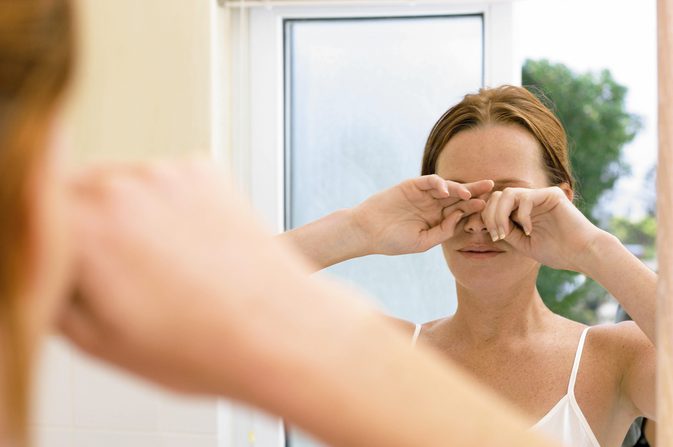Sometimes, after awakening from sleep, it is difficult to open your eyes. It usually happens because of lack of sleep, but in some cases the eyelashes are literally stuck together. The cause of this is a yellowish, sticky eye discharge, that becomes crunchy as it gets dry.
Slight eye discharge is a sign that your eyes are healthy and perform all the functions. This discharge is usually harmless and represents a natural defense of your body: this way your eyes clear out. Such rheum normally consists of dead skin cells, sebaceous and mucous secretion from eye glands, tiny foreign bodies (dust, make-up residue, etc.), that entered the eye. The discharge does not accumulate during the day as we blink frequently, and tear film helps to wash it off. When you sleep, the process does not occur, and all secretions accumulate in the inner corners of your eye and along your eyelashes.
However, sometimes eye discharge is abundant, more frequent; its color (bright yellow, green or white) and density changes. The cause and origin of this kind of eye discharge may be far more dangerous. If you suffer from heavy and unusual rheum, pay attention to the additional symptoms:
– Blurred image;
– Double vision;
– Itchy eyes;
– Dryness in the eyes;
– Eye pain;
– Eye watering;
– Redness of the eyes;
– Increased sensitivity to light.
If you notice any of these symptoms, it may be a sign of an infection or serious disease. Such rheum, besides the above listed components, consists of pus (dead white blood cells and micro-organisms, serum, etc.).
What are the causes of increased, abnormal eye discharge? There may be more than a few reasons:
– Conjunctivitis. The symptoms are red, irritated, itchy eyes, and white, greenish or yellow mucus. Conjunctivitis can be viral, bacterial or allergic.
– Blepharitis. The discharge is purulent, foamy, yellow or green; you may experience pain in the eyes, eyelids are red and swollen.
– Sty. In the case of a sty, a lump develops on an eyelid. Eyelid swells and becomes red and sensitive. The secretion is purulent, yellow.
– Dry eye syndrome. Symptoms are dry, red, bloodshot eyes, burning sensation, blurred vision, sensation of a foreign body in an eye.
– Contact lenses. Slight increase of discharge is a normal reaction of an eye when wearing lenses. However, if the discharge is abundant and persists even if you do not wear lenses for a period of time, it could be a sign of infection.
– Injury. Even a small eye lesion can cause an increase in rheum. If rheum is purulent, and it is accompanied by bleeding, seek for an emergency medical help – it is a symptom of heavy eye injury.
– In corneal ulcer purulent discharge may be particularly heavy and cover the entire cornea, significantly affecting vision. It is accompanied by eye pain and redness, swollen eyelids. This is a very dangerous disease. If untreated, can result in cloudiness of the cornea and bad vision.
– Dacryocystitis. Increased discharge is accompanied by pain in the inner corner of the eye, red bump, and swollen eyelids.
– Allergy. In allergy, rheum is more watery, transparent and less abundant. The whites of the eyes usually become red.
In addition to the above mentioned cases, eye discharge increases under the influence of infections: ocular herpes, fungal keratitis, Acanthamoeba keratitis, and many others.
Eye discharge may be accompanied by seemingly unrelated symptoms, such as fever, cough, pain of various body parts, nasal congestion, sneezing. It could be a sign of viral infection or bacterial ailment. In viral (eg. Flu) or bacterial infections, it is normal to experience an increased eye discharge. The discharge usually returns to the norm after the disease is cured.
Some of the causes that lead to increased eye discharge can be eliminated by home treatment. However, if you notice unusual discharge and a number of accompanying symptoms, consult an ophthalmologist immediately. Only a doctor can identify the exact cause of the abnormal eye discharge and prescribe the most appropriate treatment.
